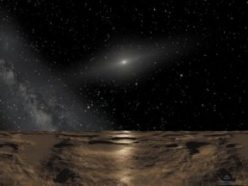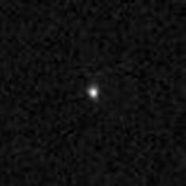Search for a Missing Moon
Sedna, the most distant object known in the solar system, doesn't appear to have a moon.
By Emily Sohn
Things just keep getting weirder out there.
In March, astronomers from the California Institute of Technology announced the discovery of a new planet-like object at the edge of the solar system. As soon as they started learning a few things about the planetoid, named Sedna, they figured it was simply a matter of time before they found a moon orbiting around it (see “Planets on the Edge” at http://www.sciencenewsforkids.org/articles/20040407/Feature1.asp ).
So far, they haven’t found it.
 |
|
This picture is an artist’s view of how Sedna’s surface might reflect the faint light of the sun.
|
| A. Schaller, NASA |
Researchers recently used the Hubble Space Telescope to take 35 images of Sedna. None showed any sign of a moon.
There’s still a small chance that there is a moon that somehow managed to hide from the camera, either behind the planetoid or in front of it. The astronomers want to take more pictures with Hubble to make sure. They also want to look with a different, redder kind of light because they think the moon, if it exists, might be brighter and easier to see in redder light.
 |
|
Sedna as seen by the Hubble Space Telescope on March 16.
|
| NASA, ESA, M. Brown |
One possible explanation for Sedna’s apparent moonlessness is that the planetoid used to have a moon that was either destroyed or yanked away by another object.
However, the gravitational pull of a moon would explain one of Sedna’s quirks: its oddly slow rotation. One spin takes 20 days. Most objects in the solar system rotate every 10 hours or so.
But it’s also possible that the astronomers determined Sedna’s spin incorrectly. It might be rotating faster than they calculated.
It’s all pretty confusing. Scientists won’t have a chance to test their theories until the fall, when Sedna moves into a good position for viewing again.
In the meantime, you now have one more mystery to ponder when you stare out into the night sky.—E. Sohn
Going Deeper:
Cowen, Ron. 2004. Puzzle on the edge: The moon that isn’t there. Science News 165(April 24):262. Available at http://www.sciencenews.org/articles/20040424/fob7.asp .
Additional information about Sedna can be found at www.gps.caltech.edu/~mbrown/sedna/ (California Institute of Technology), hepwww.physics.yale.edu/quest/sedna/sedna.html (Yale University), and hubblesite.org/newscenter/newsdesk/archive/releases/2004/14/ (Space Telescope Science Institute).







